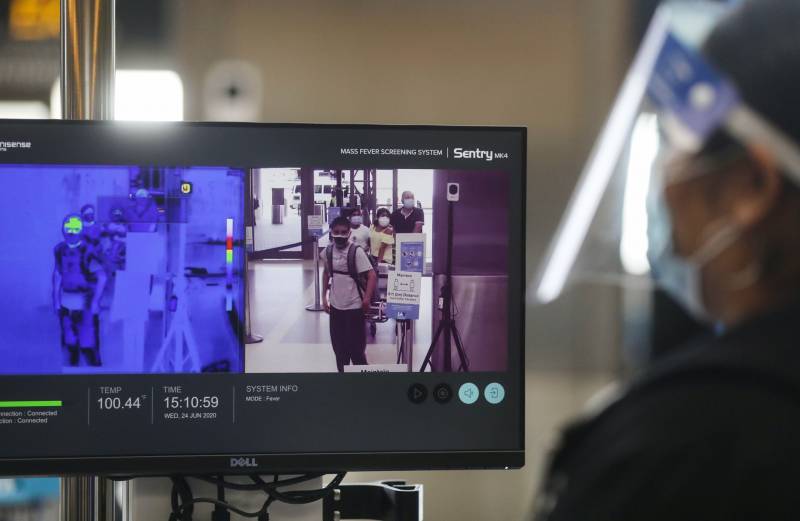There is no definitive study on the predictive value of temperature checks for COVID-19. But there are clues from when that strategy was used during the SARS epidemic of 2003. Deployed at airports, especially in Asia, the devices fell far short of the ideal, an analysis found. Although contactless thermometers are quite accurate if used correctly, many other conditions (including medications and inflammatory disease) can cause fever. As a result, the likelihood that someone with a fever had SARS ranged from 4% to 65%, depending on the underlying prevalence of the disease.
The likelihood that someone with a normal temperature reading was SARS-free was at least 86%. That suggests SARS fever checks didn’t miss many infected people. Unlike SARS, unfortunately, COVID-19 can be contagious even before an infected person runs a fever, which makes missed cases more likely.
As experts have cast around for other screening tools, some have zeroed in on smell tests, which could be as simple as asking people to identify a particular scent from a scratch-and-sniff card. Though not a universal symptom, loss of smell is one of the earliest signs of COVID-19 because of how the virus acts. Support cells in the olfactory epithelium, the tissue that lines the nasal cavities, are covered with the receptors that SARS-CoV-2 uses to enter cells. They become infected very early in the disease process, often before the body has mounted the immune response that causes fever.
“These support cells either secrete molecules that shut down the olfactory receptor neurons, or stop working and starve the neurons, or somehow fail to support the neurons,” said Danielle Reed, associate director of the Monell Chemical Senses Center, a world leader in the science of taste and smell. As a result, “the [olfactory neurons] either stop working or die.”
Can You Smell This Dill Pickle?
In an analysis of 24 individual studies, with data from 8,438 test-confirmed COVID-19 patients from 13 countries, 41% reported that they had lost their sense of smell partly or completely, researchers reported in Mayo Clinic Proceedings. But in studies that used objective measurements of smell rather than simply asking patients, the incidence of anosmia was 2.3 times higher.
A Monell analysis of 47 studies finds that nearly 80% of COVID-19 patients have lost their sense of smell as determined by scratch-and sniff tests, Reed said. But only about 50% include that in self-reported symptoms. In other words, people don’t realize they have partly or even completely lost their sense of smell. That may be because they’re suffering other, more serious symptoms and so don’t notice this one, or because smell isn’t something they focus on.
In a recent study of 1,480 patients led by otolaryngologist Carol Yan of UC San Diego Health, someone with anosmia was “more than 10 times more likely to have COVID-19 than other causes of infection,” she said. Nasal inflammation from some 200 cold, flu, and other viruses can cause it, she said, but especially during the summer, when those infections are pretty rare, the chance that anosmia is the result of COVID-19 rises.
“Anosmia was quite specific to COVID-19,” she said.
Fever, in contrast, has many possible causes. Temperature checks will therefore flag more people as potentially infected with COVID-19 than smell tests will. The likelihood that anosmia indicates COVID-19, called a test’s positive predictive value, increases as the prevalence of COVID-19 increases, as it is in many areas of the U.S.
A key unanswered question is a smell test’s “negative predictive value”: If someone has a normal sense of smell, the chance that he or she is nevertheless infected and likely contagious. Because at least some people infected with SARS-CoV-2 will have a normal sense of smell, especially early on, even experts who believe that anosmia screening can be widely beneficial — “I hope it will be used as a screening measure for the virus across the world,” Yan said — say it should be added to fever checks or other screening tools, but shouldn’t replace them.
“There is value in evaluating anosmia screening as a way to identify asymptomatic spreaders,” said Badley, the Mayo Clinic researcher.
UC San Diego Health is doing that. It asks about loss of smell (and taste) when it screens visitors and staff before allowing them to enter its buildings.
Because many people are unaware of their anosmia, testing would be even better than asking, Reed said.
The gold-standard test is the University of Pennsylvania Smell Identification Test, called UPSIT. It uses 40 microencapsulated scents — including dill pickle, turpentine, banana, soap, licorice, and cedar — released by scratching with a pencil. The test taker has a choice of four answers for each, and the whole thing takes 10 to 15 minutes.
A screening test for anosmia in the context of COVID-19 could be much simpler, experts say, especially since the idea is to identify whether individuals can smell or not, rather than whether they can discriminate different scents.
“I can see several practical ways is to have people check their sense of smell as a routine matter when entering public areas,” Reed said. Medical offices could “ask people to smell a scratch-and-sniff card and pick the correct odor out of four choices. For workplaces and schools, one way is to ask people to ‘stop and smell the roses’ as they enter buildings and report abrupt reductions in their ratings of odor intensity.”
To avoid cultural bias (not everyone knows what bubblegum or grass smells like), a test for anosmia in COVID-19 could have a standard amount of phenyl-ethyl alcohol (which smells like roses) on a swab or stick and have people sniff it, Reed said. A second stick could have less, testing for diminished sense of smell. A third stick could be a blank, to identify people who falsely claim they can smell.
This story was originally published by STAT, an online publication of Boston Globe Media that covers health, medicine, and scientific discovery.

